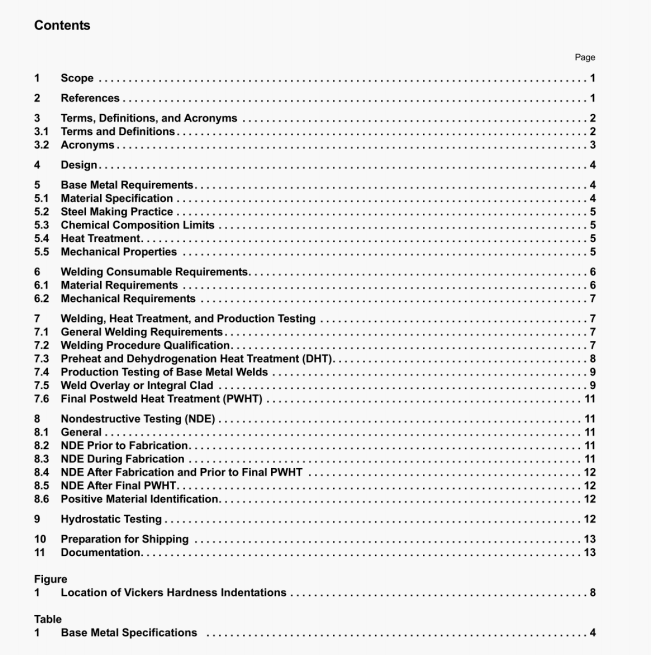API RP 934-C:2008 pdf download.Materials and Fabrication of 1 1/4cr-1/2Mo Steel Heavy Wall
Pressure Vessels for High-pressure Hydrogen Service Operating at or Below 825 °F(441 ℃).
The purpose of DHT is to drive out hydrogen to minimize the risk of hydrogen cracking, and to minimize problems due to low as-welded toughness.
7.4 Production Testing of Base Metal Welds
7.4.1 ChemIcal Composition of Production Welds
7.4.1.1 The chemical composition of the weld deposit representing each different welding procedure should be checked by either laboratory chemacal analysis or by uswg a portable analyzer of suitable accuracy and precision.
7.4.1.2 The chromium and molybdenum content of the weld deposits should be within the ranges specified in ASME BPVC, Section II, Pail C for the specified electrodes.
7.4.2 Hardness of Weld Deposit and Adjacent Base Metal
7.4.2.1 After final PWHT (see 7.6) hardness determinations should be made for each pressureretaining weld (leduding each nozzle and attachment welds) using a portable hardness tester.
7.4.2.2 Each hardness test result should be the average of three impressmns at each test location. The test locations should Include weld metal and base metals adjacent to the fusion line on both sides. All individual hardness values should be reported.
7.4.2.3 Hardness values should not exceed 225 HBW.
7.4.2.4 Hardness tests should be performed on each 10 ft (3 m) length of weld, or fraction thereof. This testing should be performed on the side exposed to the process environment when accessible.
7.4.3 Weld Impact Tests
Production test pLates subjected to the minimum and maximum PWHT should be tested and should meet the requirements of 5.5.3.
7.5 Weld Overlay or Integral Clad
Both austenitic stainless steel and femlic stainless steel may be used for integral cladding of steel. However, austenitic stainless steel is typically used for the corrosion resistant weld overlay, which also applies to clad restoration welding. The following special requirements should apply for the austenitic stainless steel overlay.
7.5.1 Material Requirements
The ferrite content of austenitic stainless steel weld overlay should be between 3 FN and 10 FN, as determined in accordance with WRC Bulletin 342. prior to any PWHT.
7.5.2 Disbonding Tests
Experience indicates that the nsk of disbonding is low at the thicknesses and hydrogen charging levels at which 1 1/4Cr-1/2Mo is used. If testing is considered, API 934-A can be used as a resource document. The purchaser should define testing requirements and acceptance criteria.
API RP 934-C:2008 pdf download
